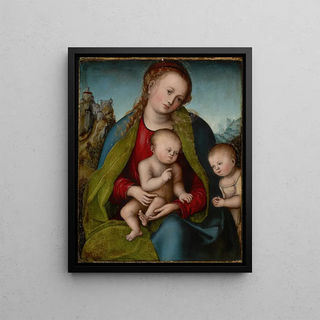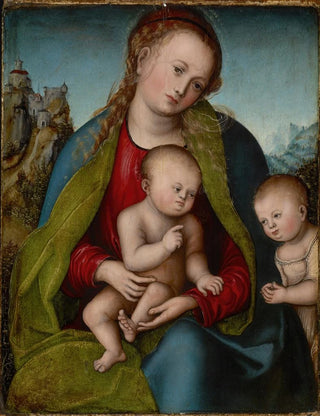Art print | La Vierge Marie avec l'Enfant et Saint Jean-Baptiste - Lucas Cranach l'Ancien


View from behind

Frame (optional)
Lucas Cranach the Elder’s work stands out in the vast panorama of the German Renaissance for its ability to blend spirituality and sensuality. "The Virgin Mary with the Child and Saint John the Baptist" is a shining example of this duality. This painting, imbued with tenderness and serenity, invites viewers to immerse themselves in a universe where Christian faith intertwines with a humanist portrayal of sacred figures. The composition, meticulously orchestrated, creates a dialogue between the characters that seems to transcend time, offering a calming and moving contemplation.
Style and uniqueness of the artwork
Cranach’s work is characterized by a distinctive style that combines elegance and simplicity. In "The Virgin Mary with the Child and Saint John the Baptist," the delicate color palette, ranging from deep blues to soft pinks, evokes an atmosphere of peace and comfort. The faces of the characters, with finely chiseled features, exude a touching expressiveness, revealing subtle emotions. The way light diffuses across surfaces and textures of the garments emphasizes the almost tactile dimension of the scene. The protective posture of the Virgin and Saint John the Baptist’s attentive gaze reinforce the idea of sacred motherhood, while also showcasing Cranach’s skill in capturing the psychological depth of his subjects.
The artist and his influence
Lucas Cranach the Elder, born in 1472, is an iconic figure of the German Renaissance. His work unfolds within an artistic context where humanism and religious reform intertwine, making him a major player of his time. As a court painter, he knew how to attract the favor of influential figures, notably the electoral family of Saxony. His innovative style, which blends Gothic tradition with Italian influences, laid the foundations for a new aesthetic in German art. Cranach was also a pioneer in depicting religious themes, approaching sacred subjects with a perspective that made them accessible and emotionally resonant. His influence continues

Matte finish

View from behind

Frame (optional)
Lucas Cranach the Elder’s work stands out in the vast panorama of the German Renaissance for its ability to blend spirituality and sensuality. "The Virgin Mary with the Child and Saint John the Baptist" is a shining example of this duality. This painting, imbued with tenderness and serenity, invites viewers to immerse themselves in a universe where Christian faith intertwines with a humanist portrayal of sacred figures. The composition, meticulously orchestrated, creates a dialogue between the characters that seems to transcend time, offering a calming and moving contemplation.
Style and uniqueness of the artwork
Cranach’s work is characterized by a distinctive style that combines elegance and simplicity. In "The Virgin Mary with the Child and Saint John the Baptist," the delicate color palette, ranging from deep blues to soft pinks, evokes an atmosphere of peace and comfort. The faces of the characters, with finely chiseled features, exude a touching expressiveness, revealing subtle emotions. The way light diffuses across surfaces and textures of the garments emphasizes the almost tactile dimension of the scene. The protective posture of the Virgin and Saint John the Baptist’s attentive gaze reinforce the idea of sacred motherhood, while also showcasing Cranach’s skill in capturing the psychological depth of his subjects.
The artist and his influence
Lucas Cranach the Elder, born in 1472, is an iconic figure of the German Renaissance. His work unfolds within an artistic context where humanism and religious reform intertwine, making him a major player of his time. As a court painter, he knew how to attract the favor of influential figures, notably the electoral family of Saxony. His innovative style, which blends Gothic tradition with Italian influences, laid the foundations for a new aesthetic in German art. Cranach was also a pioneer in depicting religious themes, approaching sacred subjects with a perspective that made them accessible and emotionally resonant. His influence continues






